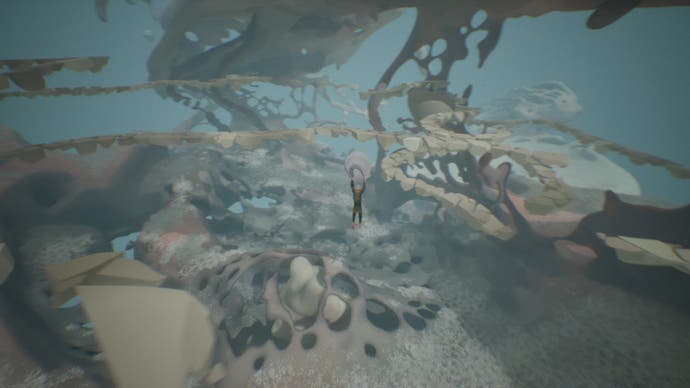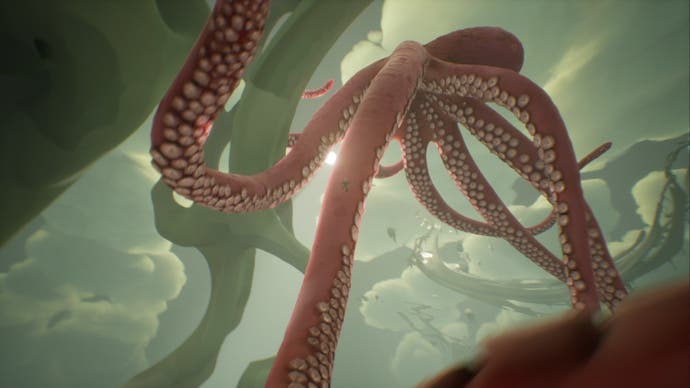Chasing the Unseen is a calmer, weirder Shadow of the Colossus
Magnum octopus.
Often all you really need in a video game is the world itself and some basic encouragement to explore it. So it proves for Chasing the Unseen, which casts you as a little boy gadding about tapering, airborne islands of rock, soil and vegetation, wrapped around each other in a silty underwater haze. It's an exercise in unhurried curiosity with just a touch of eeriness and threat. Playing through a Steam demo, I was reminded by turns of Journey's sand dunes, Halo's loopy Forerunner skyboxes and the sinewy architecture of the recent Scorn.
Chasing the Unseen's landscapes are based on fractals – briefly, mathematical shapes whose parts look the same as the whole, however far you zoom in. Montreal, Quebec-based solo developer Matthieu Fiorilli is fascinated by them. "You have these surprisingly short math formulas that yield these complex and infinite shapes," he enthuses. "You rarely see this level of complexity coming out of something so simple." Endlessly self-similar geometry may not lend itself to easy navigation, of course, so these generated archipelagoes have been carefully sculpted, their eccentricities reined in and segmented to form digestible platforming routes. Slicks of grass denote securely walkable surfaces, while patches of dense sunlight serve as end-of-level teleporters.
You have no other objective here than to ascend, using sticky, stamina-based climbing mechanics familiar from Shadow of the Colossus to haul yourself up textured surfaces such as scaly, glowing trees. You can also pop out a Breath of the Wildy parachute to glide, which again consumes stamina, and save your progress at stone cairns, which can be topped up with collectible stones for extra continues.
There's nothing to fight, and no hazards beyond the vast, cloudy void beneath, always ready to engulf you if you're a little too cocky about running along a sloped surface. It's always tempting to be cocky in Chasing the Unseen. The sweeping geography cries out to be traversed in one fell swoop, much like the alien planets of Exo One, and the boy has something of the careless momentum of Sonic the Hedgehog, tumbling uncontrollably if you land too fast, without taking damage.

But all that's before you meet your first giant flying octopus. Chasing the Unseen's worlds are home to enormous creatures who, as Fiorilli hints, "evoke certain qualities and moods that connect with the story". You'll often need to interact with these strange, oversized entities to make headway – for example, leaping onto a drifting tentacle as the octopus orbits under a spar, then hauling yourself up to its bulging, crimson head and balancing just long enough to replenish your stamina before gliding to another platform.
Later in the game there's a winding golden snake, and a silver-barked "mangrove creature" made up of flickering electrical points you can (seemingly) touch to guide its motions. The latter makes me think of Éric Chahi's otherworldly VR sim Paper Beast. Behemoths aside, each level also contains a handful of normal-sized and understandably stressed-looking capybara. Find them all to unlock – well, I'll let you discover that yourself.
Unlike Fumito Ueda's colossi, Chasing the Unseen's megafauna don't seem ill-disposed toward the presumptuous biped scaling their flanks, but they aren't exactly restful companions, either. The octopus emits a pulse-jumping orchestral track, allowing you to track its position as it disappears behind aerial islands or looms behind you. The mangrove creature is quietly horrendous: I'm not sure it has a head. They're beautiful creations, but unlike in many games that make an explicit point of not being about killing or conquest, they aren't presented as 'cuddly' or 'wholesome'. I very much doubt there's a "pet the octopus" achievement in Chasing the Unseen.
The game's explicit avoidance of bloodshed reflects its debts to Buddhist philosophy. Fiorilli won't say much about this, other than that Buddhism offers "a deep literature and a lot of inspiration to draw from". I'll resist making any heavy-handed connections myself, but a bit of slapdash, deeply uninformed Googling suggests some possible directions the game's wordless thematic journey might take. Famously, Buddhists advocate for non-human animals as fellow sentient beings, rather than creatures we are granted divine license to destroy and consume, but they also view animals a little tragically, as souls reborn into a realm of suffering. More mysteriously, there's a fractal rendering method named for the Buddha.

In terms of pure execution, Chasing the Unseen's menagerie draws on Fiorilli's extensive experience as a creature artist and animator in film, designing and rigging overclocked beasties for blockbusters like Avatar: The Way of Water and Jumanji: Welcome to the Jungle. But he's had to beat fresh paths with Chasing the Unseen. "The creatures are unique to the game, especially in the way I approached creating them which is outside of the usual techniques," Fiorilli explains. "Usually you will have two people [working on creature animations], an animator and a rigger or creature technical director, and it would be this exchange between the two.
"The rigger understands what the animator needs and then creates a setup for the creature to be animated. Kind of like a puppet. The animator takes that and animates it. For this game I'm using procedural techniques to create the animation. The mangrove is a good example of that, I'm not manually moving the limbs one by one. I created a system that moves the limbs on the ground and takes care of that."

Chasing the Unseen runs on Unreal Engine, but the creatures were modelled using Houdini, a 3D animation tool popular with VFX powerhouses like Walt Disney Animation Studios and Sony Pictures Imageworks. "I think the most unique point here is really the way the animation is done and brought into Unreal Engine," Fiorilli adds. "The system I created lets me run any kind of simulation or procedural animation in Houdini and have complete control, and then I bring everything back into the engine, and my climbing system works on the output." (If you're comfortable with terms like "LOD generation", you might want to check out Fiorilli's tech blog for the official Unreal site.)
For a game dominated by ornate, mathematical vistas and the spectacle of animal bodies, Chasing the Unseen's title might seem inappropriate, even a bit perverse. But there's a trick to it, if you pay attention, which leaves me all the hungrier for whatever lies in store beyond my demo. The game's camera hangs at a generous distance from your character, the better to drink in the world's fractal extravagance, or help you plot routes through a nest of cyclopean tentacles. As a consequence, it was only at the end of my playthrough that I noticed that the boy you're controlling is blindfolded, navigating by touch through a universe that only the player can see.


